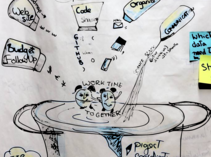
Quantitative and Predictive Infectious Disease Epidemiology
We use mathematical models to describe complex epidemiological and evolutionary processes, in order to make better predictions about the future of the epidemic. This to inform the hospital in particular and healthcare policy makers in general about the potential effectiveness of intervention measures and other policy choices. Our research focusses on antimicrobial resistance as well as respiratory infections such as COVID-19.
Projects
Our group studies the spread of antimicrobial resistance largely at the level of hospital networks. Such networks are formed by the patients exchanged and transferred between hospitals, and their structure influences the chances of AMR introduction in each hospital. We run the NEWiS project to gather information on hospital networks in multiple European countries. Furthermore, we collaborate closely with the CNAM (Paris, France), EHESP (Rennes, France), and Monash University (Victoria, Australia) to develop software solution (in the form of R packages) to facilitate network reconstruction. We further collaborate closely with the University Hospital Münster (Germany), University of Oxford (UK), UK Health and Safety Agency (UK), University Medical Center Groningen (NL) on this topic.
In spring 2024 we started a new project: ARCANE. ARCANE stands for Antimicrobial resistance control through adaptive networks, and we'll be looking at the effect of changes in hospital networks over time on the spread of antimicrobial resistance.

Analysis and Prediction Tool for COVID-19 Cases
During the COVID-19 pandemic, our group developed bed-demand forecasting models essential to the hospital’s pandemic planning. These models were generalised to fit any German hospital, based on where they think most of their admitted COVID-19 patients live. We then made this publicly available as a free online tool. The tool is continuously updated with the latest available data on regional incidence and bed occupancy. This project was the result of close collaboration with the university hospitals in Tübingen, Ulm, Heidelberg, and Mannheim.
Analysis and Prediction Tool for COVID-19 Cases
Team
| Name | 0761-270 |
|---|---|
| Fabian Bürkin, mathematician, medical statistician | 82380 |
| Dr. rer. nat. Tjibbe Donker, Group Leader, biolinformatics, medical statistician | 82550 |
| Giovanna Donvito, guest scientist | N/A |
| Marie-Rachel Garal, project coordinator | |
| Daniel Goseberg, mathematician | 82610 |
| Raisa Kociurzynski, bioinformatics | 82370 |
| Ernestina Sarmiento, guest scientist |
Publications
2024
Donker, T., Papathanassopoulos, A., Ghosh, H., Kociurzynski, R., Felder, M., Grundmann, H., & Reuter, S. (2024). Estimation of SARS-CoV-2 fitness gains from genomic surveillance data without prior lineage classification. In Proceedings of the National Academy of Sciences (Vol. 121, Issue 25). https://doi.org/10.1073/pnas.2314262121
2023
Kociurzynski, R., D’Ambrosio, A., Papathanassopoulos, A. et al. Forecasting local hospital bed demand for COVID-19 using on-request simulations. Sci Rep 13, 21321 (2023).https://doi.org/10.1038/s41598-023-48601-8
Donker T.: The dangers of using large language models for peer review. Lancet Infect Dis. 2023 Jul;23(7):781.doi: 10.1016/S1473-3099(23)00290-6. Epub 2023 May 10. Online
Scheithauer S, Dilthey A, Bludau A, Ciesek S, Corman V, Donker T, Eckmanns T, Egelkamp R, Grundmann H, Häcker G, Kaase M, Lange B, Mellmann A, Mielke M, Pletz M, Salzberger B, Thürmer A, Widmer A, Wieler LH, Wolff T, Gatermann S, Semmler T:[Establishment of genomic pathogen surveillance to strengthen pandemic preparedness and infection prevention in Germany]. Bundesgesundheitsblatt Gesundheitsforschung Gesundheitsschutz. 2023 Apr;66(4):443-449.doi: 10.1007/s00103-023-03680-w. Online
Salzberger B, Mellmann A, Bludau A, Ciesek S, Corman V, Dilthey A, Donker T, Eckmanns T, Egelkamp R, Gatermann SG, Grundmann H, Häcker G, Kaase M, Lange B, Mielke M, Pletz MW, Semmler T, Thürmer A, Wieler LH, Wolff T, Widmer AF, Scheithauer S.:An appeal for strengthening genomic pathogen surveillance to improve pandemic preparedness and infection prevention: the German perspective. Infection. 2023 Aug;51(4):805-811.doi: 10.1007/s15010-023-02040-9. Epub 2023 May 2. Online
Siebler L, Rathje T, Calandri M, Stergiaropoulos K, Donker T, Richter B, Spahn C, Nusseck M.:A coupled experimental and statistical approach for an assessment of SARS-CoV-2 infection risk at indoor event locations. BMC Public Health. 2023 Jul 20;23(1):1394.doi: 10.1186/s12889-023-16154-0. Online
2022
Budgell EP, Davies TJ, Donker T, Hopkins S, Wyllie DH, Peto TEA, Gill MJ, Llewelyn MJ, Walker AS.:Impact of antibiotic use on patient-level risk of death in 36 million hospital admissions in England.J Infect. 2022 Mar;84(3):311-320.doi: 10.1016/j.jinf.2021.12.029. Epub 2021 Dec 25. Online
2021
Donker T, Bürkin FM, Wolkewitz M, Haverkamp C, Christoffel D, Kappert O, Hammer T, Busch HJ, Biever P, Kalbhenn J, Bürkle H, Kern WV, Wenz F, Grundmann H.:Navigating hospitals safely through the COVID-19 epidemic tide: Predicting case load for adjusting bed capacity. Infect Control Hosp Epidemiol. 2021 Jun;42(6):653-658.doi: 10.1017/ice.2020.464. Epub 2020 Sep 15. Online
2020
Donker T.: Modelling how antimicrobial resistance spreads between wards. Elife. 2020 Nov 26;9:e64228.doi: 10.7554/eLife.64228. Online
Grundmann H, Donker T, Hengel H, Bürkle H, Hammer T, Wenz F, Kern W: Universelles Aufnahmescreening: Eintragungsrisiko beurteilen. Dtsch Arztebl 2020; 117(35-36): A-1610 / B-1378. Online

Dr. rer. nat. Tjibbe Donker
Biolinformatics, medical statistician
Tel.: +49 (0) 761 270 82550





